Today marks the final chapter of our Lisbon journey. So we started the morning with our habitual Portuguese breakfast—eggs paired with crispy bacon or ham, simple, pleasant and satisfying.
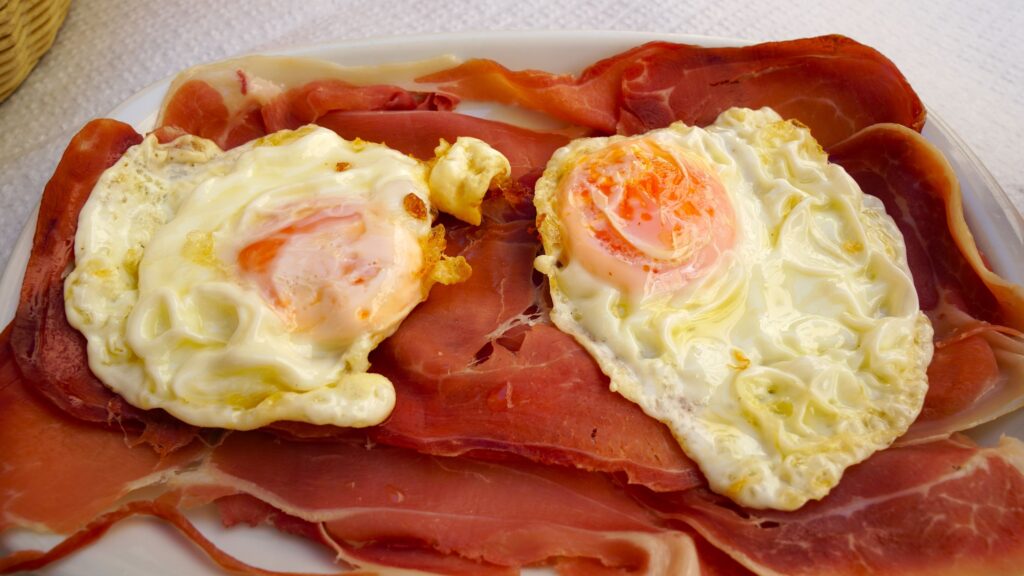

The sky was a vivid blue, a perfect backdrop for the day’s plan to explore Belém. This area is home to three iconic landmarks: Mosteiro dos Jerónimos, Padrão dos Descobrimentos, and Torre de Belém, all within a short walking distance from one another.
Getting to Mosteiro dos Jerónimos is straightforward. From Lisbon’s central district, hop on tram 15E or bus 728, and in about 20 minutes, you’ll arrive in Belém. As soon as we stepped off, the grandeur of the monastery captured our gaze. Its creamy white facade gleamed in the sunlight, a masterpiece of Manueline architecture, a style unique to Portugal. The white stone, called limestone, was sourced locally, giving the structure its radiant appearance.
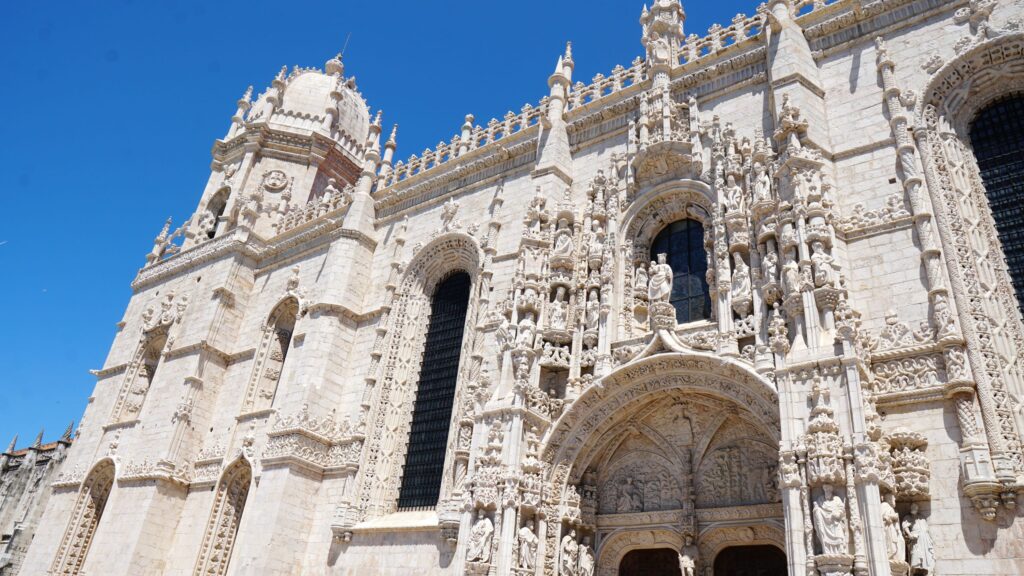
Every inch of the monastery is adorned with intricate carvings—angels, saints, nautical motifs, and vines that seem to come alive. These delicate details reflect Portugal’s Age of Discovery, symbolizing its maritime prowess. Despite the pristine whiteness, some sections of the walls have darkened with age, adding a timeless charm.

The monastery stretches across an impressive length of 300 meters. Plan to spend 1-2 hours exploring the cloisters, which are serene and intricately detailed, and the Church of Santa Maria, where the famous explorer Vasco da Gama rests. Entry costs around €12, but it’s free on the first Sunday of each month.

Adjacent to the monastery lies the Praça do Império, a sprawling square with manicured gardens that exude an English regal charm. Symmetrical flower beds, trimmed hedges, and fountains make it an ideal spot to sit and admire the monastery’s beauty.


A short stroll from the square towards the sea brings you to the striking Padrão dos Descobrimentos (Monument to the Discoveries). Towering at 56 meters, this monument celebrates Portugal’s Age of Exploration.

Shaped like the prow of a ship, it features statues of historical figures—Henry the Navigator at the helm, flanked by brave explorers, cartographers, and missionaries, their expressions carved in stone exuding courage and determination.

The structure’s massive size makes it a commanding presence, and climbing to its top (entry €6) offers breathtaking views of the Tagus River and the iconic Ponte 25 de Abril, a red suspension bridge reminiscent of San Francisco’s Golden Gate. In the distance, the Cristo Rei statue stands with open arms, as if embracing the city.
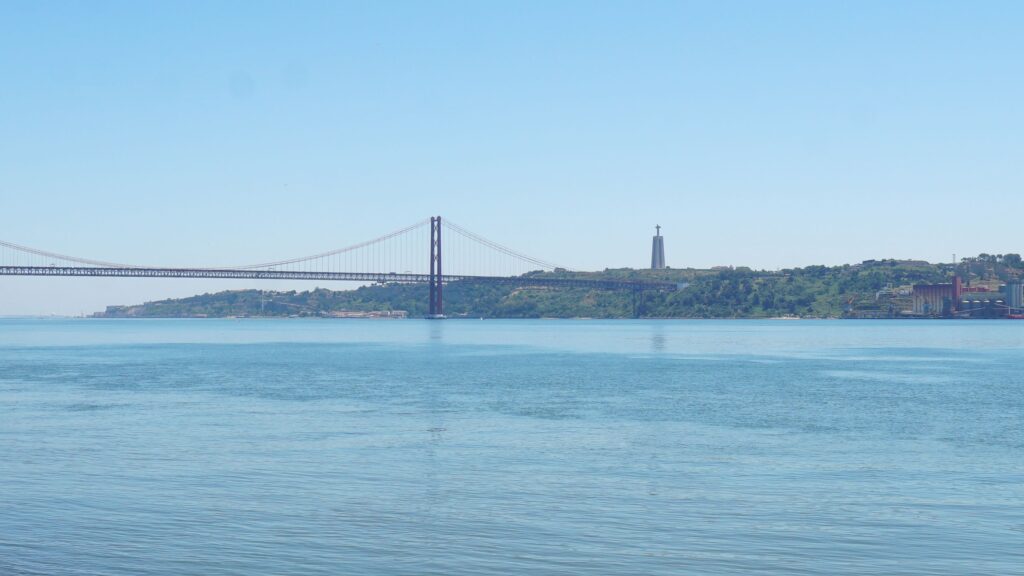
Even if you skip the climb, the view from ground level is just as stunning. Standing on the riverbank, you can soak in a similar panorama and Lisbon’s horizon beauty, where the sky and sea are veiled in a soft, dreamy haze of blue.
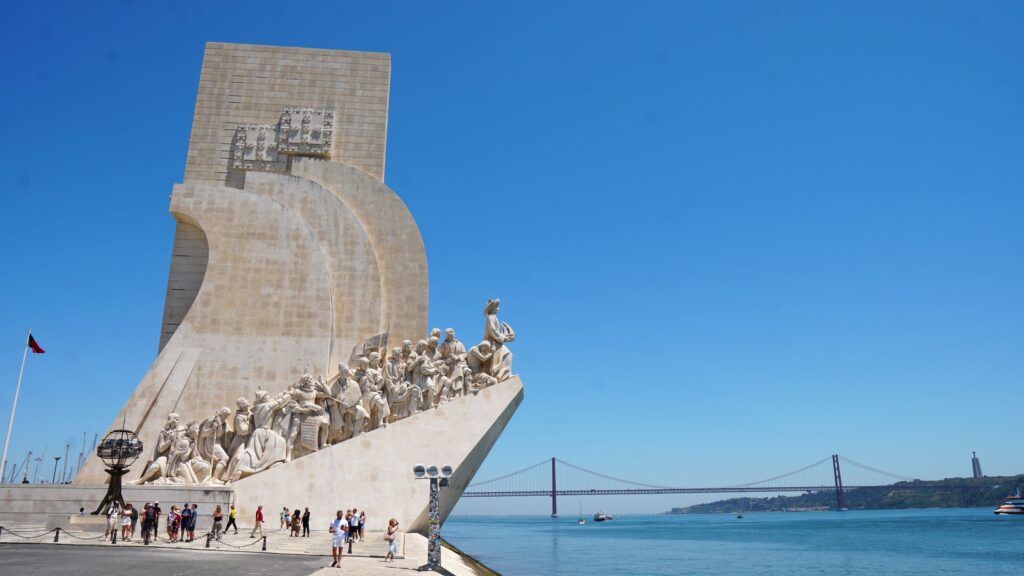
From Padrão dos Descobrimentos, a leisurely 10-minute walk along the waterfront leads to the Torre de Belém, a UNESCO World Heritage Site.
Yachts rested gracefully by the shore, including one that looked like it might belong to a distant relative of Batman—a half-boat, half-aircraft carrier marvel.


The salty breeze, shimmering waves, and distant hills make the walk very relaxing, though summer visitors should bring sunscreen as shade is sparse. Along the way, a few makeshift bars dotted the path, offering a place to rest, refresh, and unwind.
The tower, built in the early 16th century, served as both a fortress and a ceremonial gateway to Lisbon, its weathered walls bearing the marks of time. Patches darkened from the sea air only adds to its beauty. The Manueline details—twisting ropes, armillary spheres, and watchtowers—reflect its maritime heritage.

Visitors can enter the tower for €9 and climb its narrow spiral staircase to enjoy panoramic views of the river. Next to the tower is a small beach and cafés serving drinks and snacks – a nice spot to recharge while enjoying the historic ambiance.
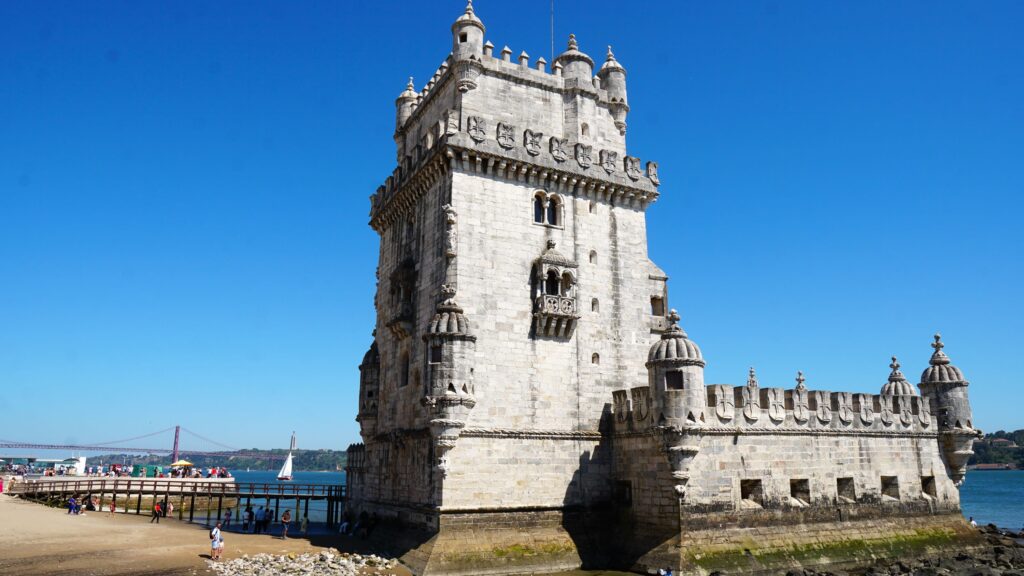
After exploring the landmarks, we took our time walking through this peaceful district Belém.

The streets are lined up with vibrant jacaranda trees, their purple blossoms painting the town in gentle splashes of color. Against the traditional Portuguese brick buildings, the scene feels like a living postcard, quietly glowing under the sun.

As the day fades, we return to the heart of the city, where lively energy pulses through the streets. Even before dusk falls, a casual snack street is already buzzing, with tables full of people celebrating the free time of the evening, basking in a golden light.

Despite the bustle, a feeling of calmness enchants, perhaps because the old trams glide by, their gentle hum adding to the timeless rhythm of the city. The blend of history and modernity, with the weight of centuries embedded in the architecture, effortlessly calms the mind, drawing you in with a magnetic pull to its rich past and old-world allure.


More tips for your visit:
- Plan for a half-day (around 4-5 hours) to visit all three landmarks at a comfortable pace, allowing time to explore the sites and relax at a riverside café.
- Mosteiro dos Jerónimos and Torre de Belém can get crowded in peak tourist seasons (spring to autumn). Early morning or late afternoon visits can help avoid the busiest times.
- If you’d like to see more of Belém’s cultural and natural side, you can visit MAAT (Museum of Art, Architecture and Technology) – a museum combining art and technology in a futuristic setting (Visit MAAT); dive into Berardo Collection Museum – home to artworks by Picasso, Warhol, Duchamp, and other Portugal’s top contemporary art collections (Visit Berardo Collection); and take a stroll in the lush, peaceful gardens in the area (see gardens of Belém)
For our last dinner in Lisbon, we found a cozy restaurant called Rico Sabor, which offers a varied menu: hamburgers, pasta, grilled beef, fish, vegetarian dishes – and of course, the dishes we’ve been eager to try or savor once more before leaving.
The first up: the appetizer – Roasted Smoked Sausage – a quintessential Portuguese specialty. Served dramatically with an open flame, the sausage arrives beautifully charred on the outside, with a crispy exterior that crackles as you cut into it. The flame-roasting process caramelizes the sausage’s natural fats, creating mouthwatering blend of smoky, savory goodness and succulent texture. Inside, the meat is firm yet tender, with its iconic robust depth of flavor.

This dish highlights the country’s passion for preserving meats and its love for bold, rustic flavors, often paired with a glass of rich Portuguese red wine.
The Grilled Whole Dorada never loses its charm. We had it earlier during our trip, but we couldn’t resist ordering it again.
The dorada arrives perfectly grilled, its skin slightly browned and crisped, with a smoky fragrance. The flesh inside is incredibly juicy, tender, and packed with the natural, delicate sweetness of the fish. A wedge of lime accompanies the fish, adding a zesty, refreshing kick that enhances the rich, savory flavors.

This dish is served alongside roasted, hearty potatoes, vegetables like flat beans and carrots, and a fresh, crisp salad – light and nutritious – complementing the succulent, fresh fish and offering a wholesome taste of coastal landscape.
We can’t end our journey without revisiting a favorite: Portuguese Seafood Rice. Often compared to Spanish paella, this dish has its own charm and story.

Traditionally prepared in large pots and shared among family and friends, Seafood Rice embodies warmth and togetherness. Its bright orange hue comes from a tomato-based sauce, simmered with olive oil, garlic, onions, and paprika. This luscious base envelops every grain of rice, creating a rich mix of flavors while keeping the grains firm and distinct. The cilantro adds a pop of green, infusing the dish with a bright herbal note.
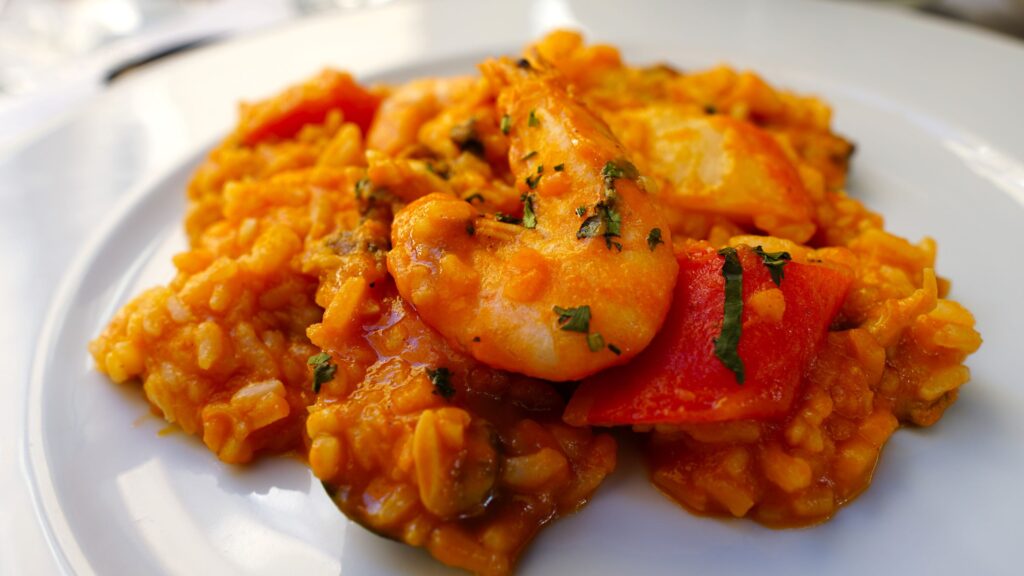
Within the dish lies a trove of the ocean’s finest: succulent shrimp, tender mussels, clams, and a seafood paste akin to surimi (蟹柳 or crab sticks), introducing an umami depth and fresh brininess that blends seamlessly with the sweet-tart tomato base. This dish is a taste of Portugal’s maritime heritage, evoking the spirit of coastal living with its every warm, soothing, flavorful bite.
For dessert, we chose Tarte Maçã com Gelado Baunilha, which marries apple flavors and vanilla in a simple yet elegant way. The dessert features a warm, perfectly baked apple tart with a crisp, buttery pastry crust. Topping the tart is a scoop of smooth vanilla ice cream, providing a cool, creamy contrast to the warm fruit filling.

The cinnamon on top lends a spiced aromatic warmth, while a drizzle of sweet, smoky syrup across the adds richness and caramelized sweetness. What a comforting end to a meal 😊
Though time has raced ahead, don’t let the sunset’s beauty just fade unnoticed. Lisbon’s sea breeze whispers by, inviting us to discover more, to love life, and to let freedom and dreams grow. This trip has shown us a lot, but there’s still more to explore—whether it’s the flavors at Time Out Market, the modern art at MAAT (Museum of Art, Architecture and Technology), or the soulful sound of a live Fado concert. These moments will be for next time then. For now, we hold onto the thrill of the uncharted, with a heart that beats for the unknown. In this life, we only ask for the courage to venture forward, without minding the directions.





Just finished reading your posts about Portugal, and I gotta say, thanks for making the city sound so amazing! I lived there for years, and your writing brought back many great memories. Keep up the good work!